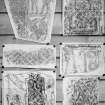Pricing Change
New pricing for orders of material from this site will come into place shortly. Charges for supply of digital images, digitisation on demand, prints and licensing will be altered.
St Vigeans
Cross Slab (Early Medieval)
Site Name St Vigeans
Classification Cross Slab (Early Medieval)
Canmore ID 35568
Site Number NO64SW 3.17
NGR NO 6383 4294
Datum OSGB36 - NGR
Permalink http://canmore.org.uk/site/35568
- Council Angus
- Parish Arbroath And St Vigeans
- Former Region Tayside
- Former District Angus
- Former County Angus
St Vigeans 17 (St Vigianus), Angus, cross-slab fragment
Measurements: H 0.31m, W 0.34m, D 0.16m
Stone type: red sandstone
Place of discovery: NO c 6384 4289
Present location: in St Vigeans Museum (HES).
Evidence for discovery: found prior to 1870 when it was built into the interior wall-face of the west gable of the church. By 1903 it had been removed and placed in the porch. It was taken into St Vigeans Museum in 1960.
Present condition: worn, with three broken edges.
Description
This fragment is part of a cross-slab carved in relief with a ringed cross with square stepped armpits, but only the lower part of the head and upper shaft survive. The slab has a plain flat-band border, and the cross is outlined by roll moulding. The shaft and lower arm are filled with pairs of linked out-turned Stafford knots. The upper part of a frontal cleric carrying a book survives to the left of the shaft. A horseman carrying a spear is carved on face C, below the lower right corner of a rectangular panel.
Date range: eighth or ninth century.
Primary references: ECMS pt 3, 275; Geddes 2017, no VIG017.
Desk-based information compiled by A Ritchie 2017.
Reference (1964)
NO64SW 3.17 6384 4294
No.17. Upright cross-slab. On the front face is the lower part of the head of the cross. The cross-shaft is decorated with interlace and has had on either side of it an ecclesiastic holding a book. On the back, a typical Pictish horseman.
S Cruden 1964


















